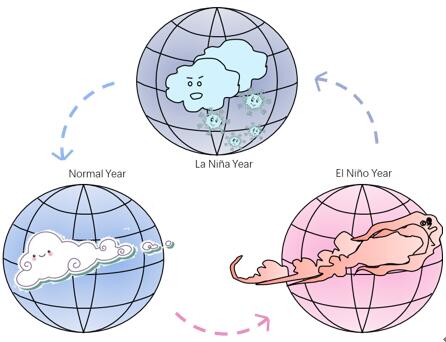The optimal precursors of sea surface temperature (SST-OPRS) using an adjoint-free method for ENSO show certain seasonal dependence in the IOCAS ICM model, according to Prof. Shijin Yuan, one of the authors of a recently published study.
"The OPRs [optimal precursors] of ENSO can be represented by the initial perturbation that most likely evolves into an ENSO event, and obtaining the OPR of ENSO can help to find the early signal that will evolve into an ENSO event and indicate the evolutionary process of the ENSO event,” says the corresponding author of the study, Prof. Yuan. “Whether the OPRs in different models show the same spatial structure is still worthy of study. In addition, how to obtain the OPRs is also a problem.”
By using the gradient-definition-based method (GD method), conditional nonlinear optimal perturbation (CNOP) approach, and the IOCAS ICM model, Prof. Yuan and his team—a group of researchers from the School of Software Engineering, Tongji University, Institute of Oceanology, Chinese Academy of Sciences, and Shanghai Central Meteorological Observatory—have had their findings about season-dependent optimal precursors of ENSO using the GD method in IOCAS ICM published in Advances of Atmospheric Sciences(https://doi.org/10.1007/s00376-019-9040-y).
In order to study the predictability of ENSO by using the adjoint-free method, the team have since 2010 been devoting considerable effort to exploring some new methods for solving the CNOP, and the GD method is one of them. It was first used to solve the CNOP in the ZC model in 2017, and then in 2019 it was used to solve the CNOP of the MM5 model to study typhoon-targeted observations.
The SST-OPRs in the IOCAS ICM model, solved using the GD method, show a positive anomaly signal in the western-central equatorial Pacific, and obvious differences exist in the patterns between the different seasonal SST-OPRs along the equatorial western-central Pacific, showing seasonal-dependence to some extent. Furthermore, non-El Nino events can eventually evolve into El Nino events when the SST-OPRs are superimposed on the corresponding seasons; the peaks of the Nino3.4 index occur at the ends of the years, which is consistent with the evolution of the real El Nino.
"The SST OPRs for ENSO depicted using the GD method provide useful information for finding the early signal of ENSO in the ICM,” Prof. Yuan believes. “To further improve the predictability of ENSO, it is necessary to study the OPRs for other physical factors related to ENSO events, such as sea level, subsurface entrainment temperature, and so on. It is also worth studying the influence of model-parameter errors on ENSO prediction and whether these errors, as with initial-condition errors, also show certain seasonal dependence. In addition, the influence of the combination of model-parameter and initial-condition errors on ENSO prediction in IOCAS ICM is another aspect worthy of study.”

Schematic diagram of a normal, El Nino and La Nina year.
Reference Mu, B., J. H. Ren, S. J. Yuan, R.-H. Zhang, L. Chen, and C. Gao, 2019: The optimal precursors for ENSO events depicted using the gradient-definition-based method in an intermediate coupled model. Adv. Atmos. Sci., 36(12), https://doi.org/10.1007/s00376-019-9040-y.
IOCAS PIO: Ms. YANG Fengfan
Phone: 86-532-82898623
E-mail: fengfanyang@qdio.ac.cn
|
|

Address: 7 Nanhai Road, Qingdao, Shandong 266071, China
Tel: 86-532-82898902 Fax: 86-532-82898612 E-mail: iocas@qdio.ac.cn


